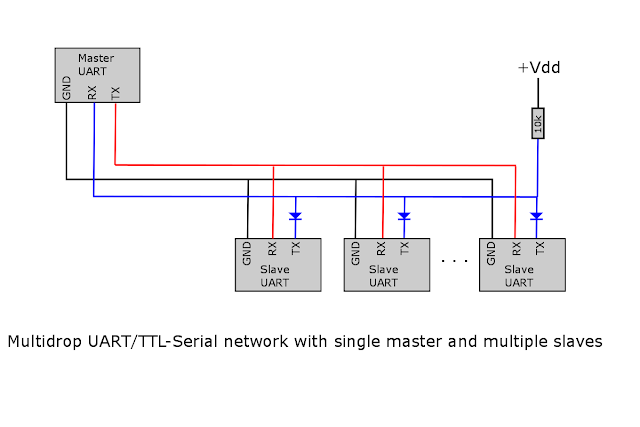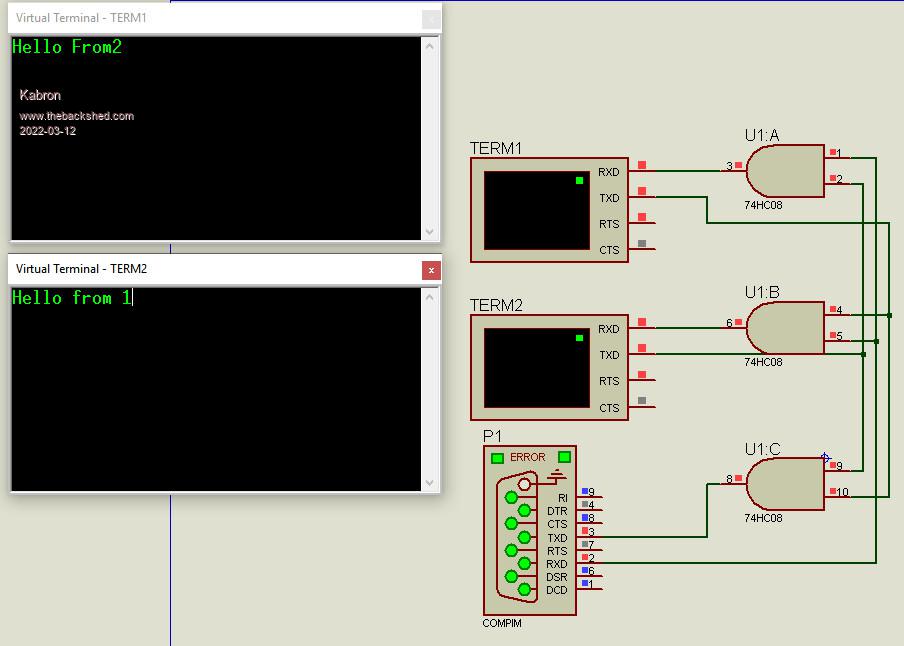
|

|
Forum Index : Microcontroller and PC projects : Multi-drop TTL
| Page 1 of 4 |
|||||
| Author | Message | ||||
| Tinine Guru Joined: 30/03/2016 Location: United KingdomPosts: 1646 |
The RS485 thread just reminded to ask if anyone has tried this (short-range) method:  Craig |
||||
| Mixtel90 Guru Joined: 05/10/2019 Location: United KingdomPosts: 8374 |
Hmmm... I2C with more complication. ;) No, not tried it. It's something I've considered many times in the past though. I seem to remember someone trying something like this many moons ago, using Nascom computers at the user group, but whether they got it to work I don't know. Can't see any obvious reason why it shouldn't. Mick Zilog Inside! nascom.info for Nascom & Gemini Preliminary MMBasic docs & my PCB designs |
||||
| Kabron Regular Member Joined: 30/11/2017 Location: GermanyPosts: 65 |
This solution works perfect in my many projects. |
||||
| CaptainBoing Guru Joined: 07/09/2016 Location: United KingdomPosts: 2171 |
electrically it looks good to me, if it wasn't so cold, I'd nip out to the shed and set up a few MM170s to play. Depending on the expected baudrate, the pull up might need to be something more aggressive like 4K7 or even 3K0 to get reasonable rise times from the slaves. You would need to establish some protocol as to who can talk, and how to encapsulate the data etc. a very similar requirement I did for a wireless HC-12 based star network. The master initiates all communication, everything has an address - master is 000, slaves are 001 - 998 and 999 is the broadcast address. Slaves only speak when spoken-to but once started they can send as many packets as they like. Here's a tiddly vid of the above protocol in action with various MMs talking with a PC master. The above said, I think Grogs has a similar case where anything can talk and collisions are just arbitrated by the software. interesting topic h Edited 2022-03-12 21:30 by CaptainBoing |
||||
| Kabron Regular Member Joined: 30/11/2017 Location: GermanyPosts: 65 |
For high speed communications it also could be done with AND-gates. |
||||
| Tinine Guru Joined: 30/03/2016 Location: United KingdomPosts: 1646 |
  What would be considered high speed? How would the AND gate solution be configured? @Mixtel90 I confess to not having studied the I2C approach. Is it possible to broadcast to multiple slaves or do they need to be individually addressed? Craig |
||||
| Tinine Guru Joined: 30/03/2016 Location: United KingdomPosts: 1646 |
@CaptainBoing Did you try pushing the HC-12s at a higher Baud? I realise that your application doesn't require it, just curious about the reliability. Regards, Craig |
||||
| Kabron Regular Member Joined: 30/11/2017 Location: GermanyPosts: 65 |
1. Does not matter from logic, depends only from transmitter-receiver capabilities. 2. See attach.  |
||||
| CaptainBoing Guru Joined: 07/09/2016 Location: United KingdomPosts: 2171 |
No, I played with 9600 a top limit with success so long as you didn't hammer them. In my applications, the packets are usually small - 100 bytes is 50 bytes of payload (because of encryption) and that is a reasonable amount of data when it is tokenised because traffic is always this message, or that message (e.g. UXR = unexpected restart etc... that particular item catches barmaids giving free snooker table time to their friends LOL) so 20 or so bytes total packet size @2400 is over in a twinkle and maximizes the range through walls & floors etc. |
||||
| CaptainBoing Guru Joined: 07/09/2016 Location: United KingdomPosts: 2171 |
The design above for AND gating; I have taken to using this range of chips recently, single gate SOT devices. would be perfcet for each module and not wasteful of gates. https://www.ti.com/lit/ds/symlink/sn74lvc1g08.pdf |
||||
| Mixtel90 Guru Joined: 05/10/2019 Location: United KingdomPosts: 8374 |
@Tinine I'm afraid I don't know much about I2c (yet). :) I know you can have multiple devices on individual addresses. I suppose you could have multiple devices *listening* on the same address, but not transmitting on it as that can mean taking bus control. If you want distance, though, RS485/RS422 is definitely the way to go. If you want local (i.e. on a single pcb) comms at high speed then serial SPI is probably the best. That AND gate approach would soon run into trouble with 20 devices. U1C would need 20 inputs. That's a horrendous amount of gating. :) In theory the wired OR gate that Tinine posted originally can have any number of devices. It might be better to use an active current source instead of a pull-up resistor though. Edited 2022-03-13 01:14 by Mixtel90 Mick Zilog Inside! nascom.info for Nascom & Gemini Preliminary MMBasic docs & my PCB designs |
||||
| Tinine Guru Joined: 30/03/2016 Location: United KingdomPosts: 1646 |
I'm liking the AND-gate approach  Craig |
||||
| Tinine Guru Joined: 30/03/2016 Location: United KingdomPosts: 1646 |
@Mixtel90 Yeah I actually run a 4-wire, full duplex (485/422) network for my distributed stuff but what I am looking at right now is 4-Picos as smart I/O expanders but these slaves will be in very close proximity to the master. Seems a bit ridiculous to use differential transceivers. I already have the protocol developed so no need to futz with I2C. Although my protocol is strictly command response, I like the full duplex approach because the master always has control of the TX and the RX is a shared response line. Should a slave get its knickers in a twist, the master is still able to talk to the other slaves, maybe to shut them down in an orderly fashion or whatever.  |
||||
| Turbo46 Guru Joined: 24/12/2017 Location: AustraliaPosts: 1649 |
It would be nice if the Tx pin could be set to OC and the Rx pins set to Pullup. The scheme would then work without any additional components. The manual doesn't mention those options for serial communications though. Bill Keep safe. Live long and prosper. |
||||
| Mixtel90 Guru Joined: 05/10/2019 Location: United KingdomPosts: 8374 |
... and you'd be back to wired OR. :) I can't understand why the AND gates would be considered better than the wired OR system. That only needs a single resistor (although I'd prefer a CC source) for the network and a diode per node. It's cheaper and simpler than any AND gate you can get. Cable capacitance is non-existent on short runs so the OR system won't be that slow. All the AND gates are doing is interlocking the TX/RX (unsuccessfully because it's on a bit by bit basis, not byte by byte) - and that's better done in software, controlled by the master. For a network of n nodes every AND gate needs n inputs. It very quickly gets out of hand. Fine for just a couple of nodes, but the wiring alone (a bus of n+1 wires) makes it unsuitable for any distance. Mick Zilog Inside! nascom.info for Nascom & Gemini Preliminary MMBasic docs & my PCB designs |
||||
CircuitGizmos Guru Joined: 08/09/2011 Location: United StatesPosts: 1427 |
I've used an open collector setup. The nearest commercial version is called LIN. LIN has a signaling method that I feel to be unnecessary involving a break condition that cant be made by a UART. My version, then, is basically LIN hardware with regular UART signaling. https://en.wikipedia.org/wiki/Local_Interconnect_Network Micromites and Maximites! - Beginning Maximite |
||||
| circuit Senior Member Joined: 10/01/2016 Location: United KingdomPosts: 293 |
If you want distance, though, RS485/RS422 is definitely the way to go. If you want local (i.e. on a single pcb) comms at high speed then serial SPI is probably the best. This obviously depends upon how distant is distant... I2C bus extenders such as the Texas Instruments P82B715 I2C Bus Extender are specified to 50 metres on the I2C bus with simple twisted pair cable. |
||||
| Tinine Guru Joined: 30/03/2016 Location: United KingdomPosts: 1646 |
Does the TX pin of the UART ever go high or does it just go low and then to high impedance? I believe that's what happens with the soft UARTS of the Propeller. Of course, I only think of this when I'm away from the shop and unable to test  It might be a non-issue from an electrical standpoint (?) @Mixtel90 I got the impression from an earlier comment that a diode might limit the bandwidth. Dunno. Craig Edit: Disregard....I've had a pint  Edited 2022-03-13 07:07 by Tinine |
||||
| Turbo46 Guru Joined: 24/12/2017 Location: AustraliaPosts: 1649 |
The diode/resistor is not an active pullup so rise time may be longer. That's why CaptainBoing suggested maybe using a lower value pullup resistor I believe. Mick's constant current source would sort of be an active pullup. Bill Keep safe. Live long and prosper. |
||||
TassyJim Guru Joined: 07/08/2011 Location: AustraliaPosts: 6397 |
I did a multidrop serial for a while but only while I was waiting for some RS422 modules to arrive. It worked well with 3 slaves but I forget what baudrate I used. Probably 38400. Cables were cat5 with the maximum distance about 8 metres. Schottky Diodes are preferred for speed. Jim VK7JH MMedit |
||||
| Page 1 of 4 |
|||||
| The Back Shed's forum code is written, and hosted, in Australia. | © JAQ Software 2025 |